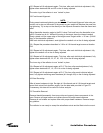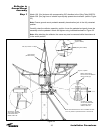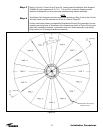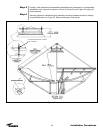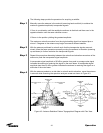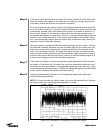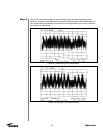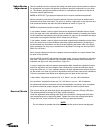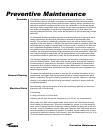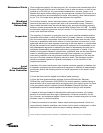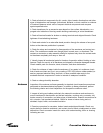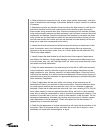
Step 5
Step 6
Step 7
Step 8
42
If the signal amplitude diminishes and does not increase (position B) to the level noted
when the antenna was peaked on the side lobe, the antenna is moving away from the
main beam; reverse the direction of the antenna movement.
From the original side lobe position (position A), the signal amplitude should now dimin-
ish to a null point at position C (minimum amplitude showing only signal noise) and then
symmetrically increase again to the same level at position D as noted at position A. At
the null point (position C), the antenna is aligned with the alternate (elevation) axis. If
the antenna was peaked on a side lobe in azimuth, it was appropriately aligned with the
elevation axis; proceed with step 6. If the antenna was peaked on a side lobe in eleva-
tion, it was appropriately aligned with the azimuth axis; proceed with step 6 moving the
antenna in azimuth rather than elevation.
Move the antenna in elevation while observing the spectrum analyzer screen. If the sig-
nal amplitude increases, deceases and then increases again but to a lesser value, the
antenna is moving in the wrong direction; reverse the direction of the antenna move-
ment. From the original null point, the signal level should increase and decrease alter-
nately, but with increasing amplitude until the transponder signal increases to a level of
at least 30 dB at which time the main beam. Continue to manually peak the signal to a
maximum level using the azimuth and elevation adjustments.
If the antenna is aligned in azimuth and elevation (signal maximized) and 24 transpon-
der signals (12 horizontal and 12 vertical) are noted, the polarization adjustment is set
incorrectly and must be modified. If 12 transponder signals are noted, they may or may
not be the properly polarized signals. Therefore 24 transponder signals must be visually
noted in order to determine the proper polarization setting.
Rotate the feed assembly clockwise until 24 transponder signals are noted and of
approximately equal amplitude.
NOTE: It is more accurate and visually easier to minimize the alternate set of transpon-
der signals rather than maximizing the transponder of interest.
Figure 4-4: Polarization at 45 degrees from Optimum Setting
Operation



